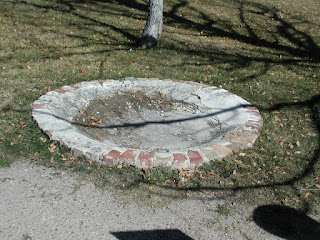So too is what has been called the
Burt House, named after Lt. Col. Andrew Burt, who served two tours of duty at
the fort.
During the fort’s final decade, boardwalks lined Officers’ Row. Houses were surrounded by picket fences, many yards had flower gardens, and women strolled along the boardwalks carrying parasols. There were even birdbaths. But, since this was Wyoming with its infamous winds, the birdbaths weren’t the typical basin-on-a-pedestal style one might find in an eastern garden. Instead, they were circular depressions in the ground, ringed by bricks or stones.
That era ended when the Army no
longer needed a large military presence in the area. In 1890 Fort Laramie was
decommissioned and its buildings sold at public auction. The fort might have
become nothing more than a memory, but a group of Wyoming residents was
determined that this part of American history not be lost. Thanks to their
efforts, the State of Wyoming acquired the fort in 1937, and in 1938 it became
part of the National Park System.
Many things have changed over the almost two centuries that a fort has existed on this site in eastern Wyoming, but what hasn’t changed is the beauty of the surrounding area and the feeling of history that surrounds visitors to the fort that welcomed so many emigrants.





No comments:
Post a Comment